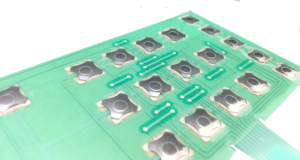Recognizing the Capability of Membrane Changes for Interface Devices
The capability of membrane layer switches over represents a significant improvement in individual interface layout, integrating performance with aesthetic adaptability. As industries progressively prioritize user experience, recognizing the subtleties of membrane switch modern technology ends up being essential.
What Are Membrane Layer Switches?
Membrane buttons are innovative user interface gadgets that assist in customer communication with electronic devices. These versatile elements contain numerous layers, consisting of a visuals overlay, spacer, and a printed circuit layer. The style enables a seamless integration right into numerous electronic devices, enhancing both the visual and practical aspects of customer interfaces.
Membrane switches are commonly used in a vast array of applications, from house devices to commercial equipment and clinical devices. Their building commonly includes a thin account, making them an excellent selection for portable styles. The responsive feedback given by these buttons can be engineered to meet details customer preferences, making sure reliable communication between the customer and the gadget.
Toughness is another significant benefit of membrane switches, as they are resistant to dust, moisture, and chemicals, which improves their life expectancy in demanding settings. In addition, these switches can be personalized in terms of form, dimension, and visuals layout, permitting branding and user-specific features. Generally, membrane switches over stand for a useful service for improving user experience in digital devices, incorporating capability with visual charm in a reliable way.
How Membrane Layer Changes Work
Operating on a straightforward concept, membrane changes utilize a layered building to register individual input successfully. Each switch is composed of multiple layers, including a published circuit layer, a spacer layer, and a leading visuals layer, which are developed to interact perfectly. When an individual presses the leading layer, it compresses the spacer layer, bringing the conductive components of the circuit layer into call with each various other.
This call produces a shut circuit, signaling the gadget to execute a certain feature. The style allows for various setups, including tactile responses, which can enhance the customer experience by supplying a physical experience upon activation. The products made use of in membrane layer switches frequently include flexible substratums, such as polyester or polycarbonate, which guarantee longevity and durability against damage.

Trick Advantages of Membrane Layer Switches

An additional significant benefit is their density. Membrane layer buttons are slim and lightweight, which enables producers to save room in their this hyperlink devices without compromising capability. This function is especially valuable in applications where weight and volume are essential factors to consider.
Additionally, membrane layer switches are resistant to dust, moisture, and chemicals, enhancing their durability. This durability expands their life expectancy and decreases the need for regular replacements, causing cost financial savings gradually.
Additionally, the tactile comments given by membrane switches can additional resources be enhanced to enhance individual interaction. They can include attributes such as elevated switches or audible clicks, improving use and individual experience.
Applications Across Industries
Interface devices using membrane switches prevail in a vast variety of industries, showcasing their adaptability and capability. Membrane Switch. In the medical field, membrane buttons are integral to gadgets such as diagnostic devices and patient monitoring systems, where their sturdiness and convenience of cleaning are crucial for maintaining health criteria. In the vehicle industry, these switches are utilized in dashboard controls and infotainment systems, offering a streamlined and modern-day interface for customers.
Furthermore, the consumer electronics market gain from membrane switches in appliances and handheld tools, where small layout and easy to use interfaces improve individual experience. Industrial applications likewise take advantage of membrane layer changes for control board in machinery and automation systems, emphasizing their robustness and resistance to rough atmospheres.
In the aerospace and protection sectors, membrane switches are utilized in cockpit controls and equipment, where dependability and efficiency under severe problems are extremely important. Additionally, the gaming industry progressively integrates membrane switches in controllers and game devices, adding to an engaging customer experience. In general, the adaptability of membrane switches over enables their widespread usage throughout countless sectors, emphasizing their significance in modern-day user interface layout.
Future Trends in Membrane Change Innovation

In addition, the usage of innovative products, such as polycarbonate and polyester films, is expected to climb, giving boosted sturdiness and resistance to ecological stressors. These products add to the total longevity of membrane layer switches, making them appropriate for important link harsher commercial applications.
Additionally, the unification of clever modern technology, including IoT connectivity, will certainly enable membrane layer buttons to connect with various other gadgets and systems, assisting in a much more interactive individual experience. This pattern straightens with the growing need for clever tools across numerous markets, from health care to customer electronics.
Finally, customization alternatives are expected to broaden, permitting manufacturers to develop bespoke services tailored to certain user requirements and preferences. These advancements will certainly place membrane layer buttons as vital elements in the evolution of customer interface innovation.
Conclusion
In verdict, membrane switches over stand for a critical development in individual interface technology, using a trustworthy and functional option for varied digital applications. As developments in product scientific research and touch noticing innovations continue, the performance and applicability of membrane layer switches are expected to broaden, reinforcing their relevance in contemporary electronic tools.